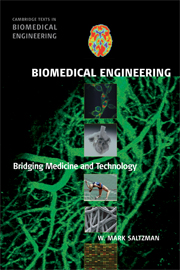Book contents
- Frontmatter
- Contents
- Preface
- Acknowledgments
- Abbreviations and Acronyms
- 1 Introduction: What Is Biomedical Engineering?
- PART 1 MOLECULAR AND CELLULAR PRINCIPLES
- PART 2 PHYSIOLOGICAL PRINCIPLES
- PART 3 BIOMEDICAL ENGINEERING
- 10 Biomechanics
- 11 Bioinstrumentation
- 12 Bioimaging
- 13 Biomolecular Engineering I: Biotechnology
- 14 Biomolecular Engineering II: Engineering of Immunity
- 15 Biomaterials and Artificial Organs
- 16 Biomedical Engineering and Cancer
- Appendix A Physiological Parameters
- Appendix B Chemical Parameters
- Appendix C Units and Conversion Factors
- Index
- Plate section
- References
14 - Biomolecular Engineering II: Engineering of Immunity
from PART 3 - BIOMEDICAL ENGINEERING
- Frontmatter
- Contents
- Preface
- Acknowledgments
- Abbreviations and Acronyms
- 1 Introduction: What Is Biomedical Engineering?
- PART 1 MOLECULAR AND CELLULAR PRINCIPLES
- PART 2 PHYSIOLOGICAL PRINCIPLES
- PART 3 BIOMEDICAL ENGINEERING
- 10 Biomechanics
- 11 Bioinstrumentation
- 12 Bioimaging
- 13 Biomolecular Engineering I: Biotechnology
- 14 Biomolecular Engineering II: Engineering of Immunity
- 15 Biomaterials and Artificial Organs
- 16 Biomedical Engineering and Cancer
- Appendix A Physiological Parameters
- Appendix B Chemical Parameters
- Appendix C Units and Conversion Factors
- Index
- Plate section
- References
Summary
LEARNING OBJECTIVES
After reading this chapter, you should:
Understand the role of vaccines in the prevention of disease.
Understand the role of antibodies (Abs) in the immune system, and some of the ways that Abs can be used to prevent disease in humans.
Understand the basic elements of Ab structure, and the difference in chemical structure between Ab classes.
Understand the difference between monoclonal and polyclonal Abs.
Understand how monoclonal antibodies (mAbs) are manufactured.
Understand some of the basic approaches for vaccine development.
Prelude
The previous chapter introduced three of the major subjects of interest in biomolecular engineering: drug delivery, nanobiotechnology, and tissue engineering. This chapter focuses on additional applications of biomolecular engineering, particularly approaches for enhancing the function of the immune system. The most familiar application of biomedical engineering (BME) in immunology is the development of vaccines.
The development of vaccines that are both safe and effective has been one of the great achievements of modern medicine. Because of an effective vaccine, smallpox—a frequently fatal disease that claimed thousands of lives in previous centuries—has been eradicated, or eliminated as a natural infectious agent. Other severe infectious diseases, such as polio and influenza, are now in control in most countries of the world. There are, however, many diseases that have proven to be difficult for vaccine makers. Acquired immune deficiency syndrome (AIDS), which is caused by infection with human immunodeficiency virus (HIV), has killed millions of people worldwide (Figure 14.1), and there is still no effective vaccine available.
- Type
- Chapter
- Information
- Biomedical EngineeringBridging Medicine and Technology, pp. 507 - 536Publisher: Cambridge University PressPrint publication year: 2009

